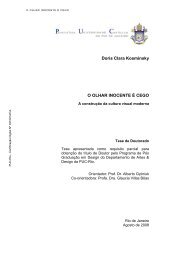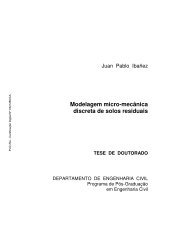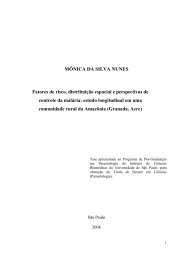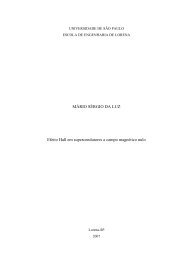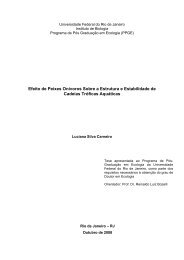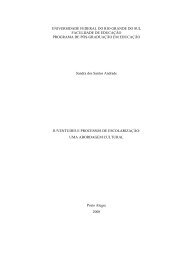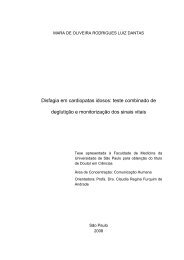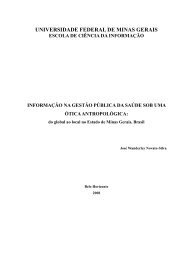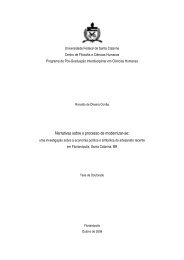Create successful ePaper yourself
Turn your PDF publications into a flip-book with our unique Google optimized e-Paper software.
224Deletion of the IL-7 <strong>gene</strong> delays V(D)J recombination ofthe TCRβ, γ and δ loci during fetal development in mice [6].Recent studies have shown that IL-7 plays a decisive rolein thymus maturation and T-cell differentiation modulatingTCRα/β and γ/δ locus accessibility to the V(D)J recombinase[8, 9].The function of T-cell receptors (TCRα/β) is related to therecognition of a processed non-self antigen together with aself molecule of class I or class II MHC. It is plausible toconsider that these molecules expressed in the thymus environmentmay play a role in T-cell maturation [10].The TCRβ receptor is of particular interest because thereis evidence for its essential role in TCRα/β differentiation.Thymuses of mice with a mutation in TCR <strong>gene</strong>s contain 10-fold fewer cells than thymuses of wild-type mice and 50%of these cells are <strong>do</strong>uble positive, indicating that the recombinationand/or expression of TCRβ is required formaturation [11]. Moreover, the TCRβ enhancer controlsthe recombinations of its own locus [12].To further evaluate the association of several other <strong>gene</strong>products with the evolution of TCRVβ8.1 V(D)J rearrangementsin vivo, the mRNA expression levels of seven interleukins(IL-1α, IL-1β, IL-2, IL-3, IL-4, Il-6, IL-7), threecytokines (TNF-β, IF-γ and GM-CSF), receptors IL-2Rβ andTCRVβ8.1, MHC-I and MHC-II, RAG-1 and RAG-2 andretroviral superantigen MMTV(SW) were measured by RT-PCR during the in vivo fetal development of the thymus ofthree inbred mouse strains (Balb-c, C57Bl/6 and CBA/J).The expression profiles were examined using the GeneCluster method and visualized with the TreeView software[13, 14]. The inbred strains displayed distinct <strong>gene</strong> expressionsignatures.These data, when compared with the evolution of TCRVβ8.1rearrangements, which were also distinct among strains, permitteda direct visualization of the effect of <strong>gene</strong>tic backgroun<strong>do</strong>n the modulation of V(D)J recombination.Materials and methodsTCRVβ8.1-Dβ2.1 V(D)J recombination assayRearrangements between segments TCRVβ8.1-Dβ2.1 duringthymus development were investigated by PCR as previouslydescribed [3]. The oligonucleotide primers used were theVβ8.1 forward primer (primer 1, GAGGCTGCAGTCACC-CAAAGTCCAA) the Vβ8.1 reverse primer (primer 2, ACA-GAAATATACAGCTGTCTGAGAA) and the Jβ2.1 reverseprimer (primer 3, TGAGTCGTGTTCCTGGTCCGAAGAA).The PCR reaction mixture contained 35 mM TRIS (pH 8.3),50 mM KCl, 2.5 mM MgCl 2, bovine serum albumin (100 µg/ml), nucleotide triphosphates (NTPs) (2 µM each), the primers(0.5 µM each), 1U Taq polymerase (Amersham Biosciences),with a constant amount of genomic DNA (1 µg)from each developmental stage. The PCR program consiste<strong>do</strong>f 30 cycles (1 min at 94°C, 2.5 min at 54°C, and 1.5 min at70°C, with a 7-min extension period). The PCR product obtainedwith primers 1 and 3 was resolved on 1.2% agarosegel and blotted on Hybond Nylon + (Amersham Biosciences).The rearranged Vβ8.1-Dβ2.1 330 bp segment was detectedby Southern hybridization with the 32 P-labeled PCR productof 100 bp obtained with primers 1 and 2 and quantified usinga phosphor imager system (Cyclone, Packard Co., USA)and the OptiQuant ® software.Reverse transcription-PCR (RT-PCR)The <strong>gene</strong> transcriptions were quantified with cDNA preparedfrom total thymus RNA.Balb-c, C57Bl/6 and CBA/J mice were mated by isogeniccrosses, pregnant females were sacrificed by ether inhalationand fetuses surgically collected from the uterus. The age of thefetuses (as days p.c.) was confirmed on the basis of the morphologicalcharacteristics of each phase of development [15].Thymus tissue (one milligram containing approximately1 × 10 7 cells) from fetuses at different developmental stages(14–17 days p.c.) and from new born pups and adults wasobtained by surgery under a stereomicroscope and immediatelyprocessed for total RNA using Trizol ® reagent (Invitrogen).The cDNA samples were obtained by reverse transcriptionfrom thymus total RNA using the Super Script II enzyme an<strong>do</strong>ligo dT 12–18to prime the reaction according to the instructionsof Invitrogen. The cDNA was used as template for PCR(RT-PCR) using the primers for <strong>gene</strong>s listed in Table 1. ThePCR mixture was as described for the V(D)J recombinationassay with a constant amount of cDNA from each developmentalstage. The PCR program consisted of one cycle at94°C for 1 min, 30 cycles (1 min at 94°C, 1 min at 60°C (exceptfor IL-1α at 55°C), 1 min at 72°C), and a 1-min extensionperiod.These conditions permitted proportional amplificationsaccording the expression levels, enough to be detected bythe oligonucleotide hybridizations and quantified using thephosphorimager system.The RT-PCR products were blotted on nylon Hybond N+(Amersham Pharmacia Biotech) using a 96 well Hybri-DotManifold (Life Technologies, Inc.). The mRNA expressionlevels were detected by hybridization with 33 P-labeled specificoligonucleotides internal to each cDNA (Table 1), exceptfor TCRVβ8.1, RAG-1 and RAG–2, MHC-I and MHC–II,whose probes were the 32 P labeled PCR product obtained withforward and reverse primers and quantified using the phosphorstorage system as mentioned above. The values werenormalized on the basis of β-actin expression in each totalRNA sample.



